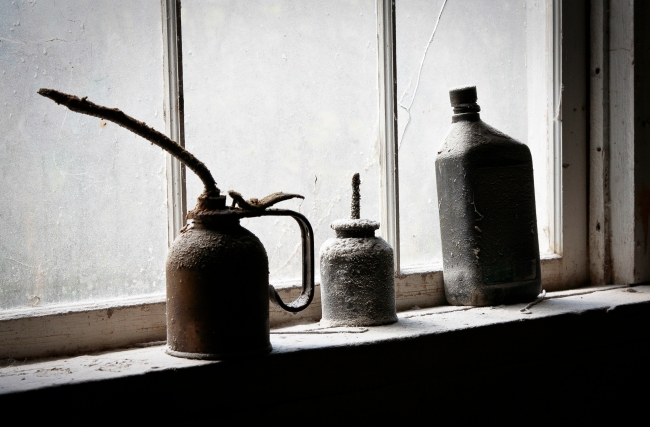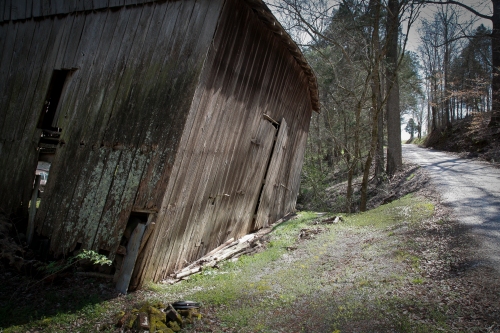Mills and Fords
I found myself up at Falls Mills near Belvidere, Tennessee a few days ago. A friend invited me to go along with him, to check out the place and assess the progress they have made on restoring the old grist mill. I cannot remember a time when the mill was not undergoing some sort of restorative effort. The place has changed hands many times through the years, and each new owner builds upon the progress made by the previous one. Currently, Falls Mill operates as a water-powered grain mill, but it has not always been so. Built in 1873, the mill was originally a cotton and woolen factory, and later converted into a cotton gin and woodworking shop. Today, visitors can watch as cornmeal, flour and grits are produced and sold.
The mill also functions as a museum, and in time, the owners hope to install a working loom on the top floor of the brick building. Visitors will be able to get a sense of what it was like when the mill operated as a textile factory. My friend, also a photographer, spent most of his time on the top floor, capturing images on film with his 8×10 Deardorff camera. Sections of the loom are already in place, and there were parts of machinery all over. Visitors are not normally permitted up here, but my friend convinced the caretaker that he had been granted permission on an earlier visit, and asked if he could bend the rules just one more time. He did.
While my friend kept busy photographing parts of the loom and wool carding machine, I focused on some of the smaller items, things that once were used in the process of making cloth. Frankly, all those dusty machines didn’t get my creative juices flowing. I did find a few scenes I thought might be interesting to photograph, but my mind was really on this old Ford pickup truck I had seen as we drove up that morning. Located near a caretaker’s shed, and not far from the restrooms, it was calling to me to come pay a visit. My companion had photographed it on his previous visit, so he chose to stay put and continue photographing those old dusty machines. Admittedly, shooting film with a large format camera is a slow process. Film, being as expensive as it is, especially at this size, forces an artist to be very deliberate in his approach. I mean, at $5.00 a pop, one tends to think everything through a couple of times, before making the commitment to snap the shutter. Those of us who work primarily in digital, don’t have those constraints. We can shoot two hundred images of the same inanimate object without any financial consideration. And, we often do.
The Ford pickup was old, but I couldn’t tell you the year. I am just not that familiar with trucks, never having owned one. After 40 years of living in the south, I hate to admit that fact, but at the same time, I’m quite amazed that I have been able to resist that customary rite of passage for so long. The truck was definitely old, and it appeared to have been painted a few times. The shine was long gone, but I couldn’t tell if it still worked. I wouldn’t be surprised if it still did. These old vehicles have a way of lasting far longer than their appearance would indicate. The truck was well protected under the roof of the shed, which would lead one to think that it did, indeed, still run. I mean, who would bother to keep it out of harms way if it was just a junker? Right? But then, I saw all the rust. There was a lot of it. Now, I realize that the presence of rust is not a definitive indicator of a vehicle’s operational status, but it is an important sign. Never matter, I didn’t hope to drive the thing – I wanted to photograph it. To me, the rust only added to the character of the truck. Rust is good.
I ended up concentrating on photographing just the front end of the Ford. It was easily the most interesting side, and it was the only portion in bright sunlight, which I needed to properly highlight that glorious rust. I shot with both the Leica M9 and the Canon 5D. The Leica gave me good results, but I stayed with the Canon because the 24-1oomm and 100mm macro lenses allowed me to frame the shots tighter. Besides, I wanted to do an HDR shot, and my Leica wouldn’t fit the one tripod I had brought along that day. HDR images require a rock-steady platform since you have to take multiple exposures in the same exact spot. No hand-holding here. After shooting all different angles, from far away to closeup, I settled on this view above because it included a bit of an old cabin in the background. I thought it complimented the composition and the vintage look of the truck.
You may wonder why I have not bothered to show a picture of the mill itself by this point. To be honest, I couldn’t warm up to the structure. Granted, it’s a very handsome building, nestled in the rolling hills of southern Tennessee . It’s large and constructed of old brick and a lot of thought must have gone into its planning and building for it to have endured for almost 140 years. The problem, I decided, was not with the mill itself, but with the fact that it was the wrong time of year to photograph the place. In early summer, when the trees have finally unfurled their leaves, or in fall, when those same leaves turn vibrantly colorful, are the best times to photograph Falls Mill. At those times, the 32-foot waterwheel is artfully framed by the dense foliage, and the water flows freely. Early spring could only offer a promise of things to come. The trees and vines were just beginning to green-up, and although this winter has been unusually warm, it wasn’t enough to coax the new year’s growth sufficiently for my purposes.
For those reasons, I decided to concentrate on photographing the southern exposure. I am sure most visitors seldom really see this side of the mill, and give it only a passing glance as they head down to the Factory Creek, the waterwheel and cascading falls beyond. The three-story building also houses the Museum of Power and Industry, a rather lofty name for a collection of antique textile equipment originally donated by another mill in Kentucky. A barn loom and power-loom donated from Scotland are among the artifacts housed inside the mill. Today, as a gristmill, the two sets of grinding stones produce grain for over 85 wholesale accounts. Cornmeal, flour and grits are also available for purchase on site.
Surrounding the mill are a number of buildings of lesser importance, and even private homes lie within just a stone’s throw of it. At one point, my friend was rather rudely informed, that where he was standing was actually private property. It’s easy to miss the demarcation line between private land and mill property. They butt right up to each other. We had to inquire if the main road running past the mill was private as well, and were told that it was, but everybody used it. We had to scratch our heads with that response and didn’t bother waiting for clarification. Photographers typically go where they please, and wait to see if anyone objects. Generally, if someone does (this is rare), it doesn’t happen immediately. By the time they do, you have already taken the photo and it’s “in the can.” That was the case with this severely leaning hay barn located just across the road from the mill. It looked like it could fall over at any minute, but somehow, I knew it probably still had a few good years left in it.
It’s wonderful to see old mills like this one continue to function. If you like these old mills too, you can help keep them a part of the landscape. They are all too fast disappearing from the American scene. I encourage you to support the Society for the Preservation of Old Mills (SPOOM). This organization is dedicated to preserving historic mills and informing the public about the significance of the milling industry in early America.
Falls Mill is a short drive (35 miles) from Huntsville through some very pretty country. Just head up towards Huntland, Tennessee. You’ll find the road to the mill right off state highway 64. It’s open year-round, closing only from Christmas Eve through the second week in January. The mill is closed on Wednesdays throughout the year.












